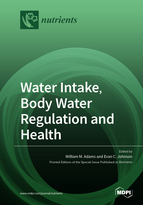Water Intake, Body Water Regulation and Health
A special issue of Nutrients (ISSN 2072-6643).
Deadline for manuscript submissions: closed (30 June 2019) | Viewed by 137070
Special Issue Editors
Interests: fluid regulation; hydration physiology; hydration issues in sports and physical activity; thermal physiology; exertional heat illness
Special Issues, Collections and Topics in MDPI journals
Special Issue Information
Dear Colleagues,
The purpose of this Special Issue, “Water Intake, Body Water Regulation and Health,” is to present novel reviews and experimental data regarding hydration physiology and its implication in overall health. Water has previously been dubbed the forgotten nutrient due to humans’ and animals’ ability to subsist seemingly unchanged across a wide range of daily water intake. However, with the introduction of stressors such as exercise, diseased states, and/or chronic high or low water intake, the homeostatic signals related to body water regulation can influence organ and whole-body health. This Special Issue will discuss water intake, the scientific rationale surrounding the U.S. and European water intake guidelines, homeostatic mechanisms, diseases related to dysfunction of water regulation, and differences in the volume and the vehicle in which the water is contained (i.e., plain water versus mixed beverages) on water intake during and following exercise. It is our aim to continue discussion surrounding water, the previously forgotten nutrient, and highlight the importance of water in daily life.
Dr. William M. Adams
Dr. Evan C. Johnson
Guest Editors
Manuscript Submission Information
Manuscripts should be submitted online at www.mdpi.com by registering and logging in to this website. Once you are registered, click here to go to the submission form. Manuscripts can be submitted until the deadline. All submissions that pass pre-check are peer-reviewed. Accepted papers will be published continuously in the journal (as soon as accepted) and will be listed together on the special issue website. Research articles, review articles as well as short communications are invited. For planned papers, a title and short abstract (about 100 words) can be sent to the Editorial Office for announcement on this website.
Submitted manuscripts should not have been published previously, nor be under consideration for publication elsewhere (except conference proceedings papers). All manuscripts are thoroughly refereed through a single-blind peer-review process. A guide for authors and other relevant information for submission of manuscripts is available on the Instructions for Authors page. Nutrients is an international peer-reviewed open access semimonthly journal published by MDPI.
Please visit the Instructions for Authors page before submitting a manuscript. The Article Processing Charge (APC) for publication in this open access journal is 2900 CHF (Swiss Francs). Submitted papers should be well formatted and use good English. Authors may use MDPI's English editing service prior to publication or during author revisions.
Keywords
- Hydration Status
- Homeostasis
- Thirst
- Sweat Physiology
- Fluid Balance
- Fluid Consumption








